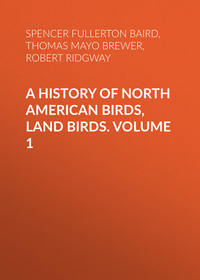 полная версия
полная версияA History of North American Birds, Land Birds. Volume 2
Mr. Salvin found the bird very abundant in Central America. In one of his papers relative to the birds of that region, he states that this species, in Guatemala, plays the part of the European House Sparrow. It seeks the abode of man, as does that familiar bird, and is generally found frequenting larger towns as well as villages. Stables are its favorite places of resort, where it scratches for its food among the ordure of the horses. It will even perch on the backs of these animals and rid them of their ticks, occasionally picking up stray grains of corn from their mangers. At Duenas he found it breeding in large societies, usually selecting the willows that grow near the lake and the reeds on the banks for its nest. The breeding season extends over some length of time. In May, young birds and fresh eggs may be found in nests in the same trees. On the coast, young birds, nearly capable of flying, were seen in the early part of March. Mr. Salvin adds that the nests are usually made of grass, and placed among upright branches, the grass being intwined around each twig, to support the structure. The eggs in that region were seldom found to exceed three in number.
Mr. Dresser found the Long-tailed Grakles very common at Matamoras, where they frequented the streets and yards with no signs of fear. They were breeding there in great quantities, building a heavy nest of sticks, lined with roots and grass. They were fond of building in company, and in the yard of the hotel he counted seven nests in one tree. At Eagle Pass, and as far east as the Nueces River, he found them not uncommon, but noticed none farther in the interior of Texas. Their usual note is a loud and not unmelodious whistle. They have also a very peculiar guttural note, which he compares to the sound caused by drawing a stick sharply across the quills of a dried goose-wing.
Captain McCown states that he observed these Blackbirds building in large communities at Fort Brown, Texas. Upon a tree standing near the centre of the parade-ground at that fort, a pair of the birds had built their nest. Just before the young were able to fly, one of them fell to the ground. A boy about ten years old discovered and seized the bird, which resisted stoutly, and uttered loud cries. These soon brought to its rescue a legion of old birds, which vigorously attacked the boy, till he was glad to drop the bird and take to flight. Captain McCown then went and picked up the young bird, when they turned their fury upon him, passing close to his head and uttering their sharp caw. He placed it upon a tree, and there left it, to the evident satisfaction of his assailants. These birds, he adds, have a peculiar cry, something like tearing the dry husk from an ear of corn. From this the soldiers called them corn-huskers. He often saw other and smaller birds building in the same tree. They were very familiar, and would frequently approach to within ten feet of a person.
The eggs measure 1.32 inches in length by .92 of an inch in breadth, and exhibit great variations both in ground-color and in the style and character of their marking. In some the ground-color is of a light grayish-white with a slight tinge of green or blue; in others it is of a light drab, and again many have a deep brownish-drab. The markings are principally of a dark brown, hardly distinguishable from black, distributed in the shape of drops, or broad irregular narrow plashes, or in waving zigzag lines and markings. Intermingled with these deeper and bolder markings are suffused cloud-like colorations of purplish-brown.
Family STURNIDÆ.—The Starlings
Char. General characters of the Icteridæ, but with a rudimentary first primary, making the total number ten.
The introduction of this family into the present work is required by the occurrence of the typical species, Sturnus vulgaris, in Greenland, although it otherwise characterizes the Old World exclusively. There are several subfamilies, principally African and East Indian (Lamprotornithinæ, Buphaginæ, Sturninæ, and Graculinæ), some of them of very brilliant plumage.
The Sturnidæ in many respects constitute a natural stage of transition from the Icteridæ to the Corvidæ, through the Jays.
Genus STURNUS, LinnæusSturnus, Linn. Syst. Nat., I, (ed. 10,) 1758, 167. (Type, S. vulgaris.)
Gen. Char. Bill long, conical, much depressed; the culmen, gonys, and commissure nearly straight, the latter angulated at base. Wings, twice length of tail; much pointed, the primaries graduating rapidly from the second, the first being rudimentary, the secondaries much shorter. Tail nearly even; the feathers acuminate. Tarsi short; about equal to middle toe; lateral toes equal. Plumage coarse and stiff, each feather distinctly outlined.
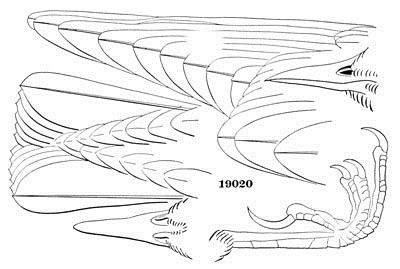
Sturnus vulgaris.
19020
The bill of Sturnus is very similar to that of Sturnella, although less inflected at the edges. The shorter tarsi, much longer wings, with the innermost secondaries much less than the primaries, etc., readily distinguish the two families.
Sturnus vulgaris, LinnTHE STARLINGSturnus vulgaris, Linn. Syst. Nat. I, (ed. 10,) 1758, 167; (ed. 12,) 1766, 290.—Degland & Gerbe, Orn. Europ. I, 1867, 232.—Reinhardt, Ibis, 1861, 7 (Greenland).
Sp. Char. Feathers principally lustrous-black, with purple and green reflections, except at their extremities, which are dull and opaque; brownish above, silvery-white beneath. Bill yellow in spring, brown in autumn. Legs flesh-color. Length about 8.51; wing, 5.11; tail, 2.81; bill above, 1.11, from nostril, .75; gape, 1.15; tarsus, 1.15; middle toe and claw, 1.15. Female similar, but less brilliant.
Hab. Europe and North Africa, most abundant in Holland. One specimen killed in Greenland, in 1851, and preserved in the Royal Zoölogical Museum of Copenhagen.
The preceding description will serve to distinguish the Starling from any North American species, although it is subject to considerable variation. A second form, scarcely distinguishable as a species (S. unicolor, De la Marmora), of a prevailing black color, without terminal spots, and with the feathers of the under part elongated, is found in Sardinia and Sicily.
Habits. We give a place to the common Starling of Europe in the fauna of North America, as an occasional and rare visitant of Greenland. Only a single instance is on record of its actual capture,—a female taken by Holböll in 1851, and now in the Royal Museum of Copenhagen.
The well-known Starling of Europe is handsome in plumage and of graceful shape. It is numerous, as a species, is very generally distributed, and therefore very well known. With many it is a great favorite, and is also familiar as a caged bird. Its sprightly habits, retentive memory, and flexibility of voice, commend it as an interesting and entertaining pet. It has been taught to whistle tunes, and even to imitate the human voice, with facility and correctness. In its natural state it is a very social bird, and lives in flocks the greater part of the year.
Mr. Waterton, who was a great admirer of the Starling, sought to induce these birds to frequent his grounds, and with this view made various cavities in the walls of an old tower near his residence. His wishes were gratified, and soon every cavity he had made was taken possession of by a pair, and many more would have been thus domiciled had provision been made for them.
A similar instance is on record in Hamburg, where, within a few years, a well-known horticulturist induced nearly two hundred pairs of Starlings to occupy and to breed in wooden boxes put up in his grounds for their accommodation. His plants had been destroyed by the attacks of hosts of subterranean larvæ, and the Starlings were invited in the hope that they would remove this evil, which they did quite effectually.
Dr. Beverley Morris gives a very interesting account of a female Starling that he observed building a nest in a hollow tree. The male looked on, but took no part, except to drive away other intrusive birds. The female made on an average three trips a minute, with small twigs and bits of dry grass, taking sometimes three or four at a time. He estimated that in the space of six hours she had taken to her nest not less than a thousand sticks.
The Starling is said to select for its nest suitable places in church-steeples, the eaves of houses, and holes in walls, especially of old towers and ruins; occasionally it builds in hollow trees, in cliffs or in high rocks overhanging the sea, and also in dovecotes. The nests are made of slender twigs, straw, roots, and dry grasses. The birds incubate sixteen days. The old birds are devoted to their offspring.
Almost as soon as the nestlings are able to fly, different families unite to form large flocks, which may be seen feeding on commons and grass-grounds, in company with the Rooks and other birds. Their chief food consists of larvæ, worms, insects in various stages, and, at times, berries and grain. In confinement they are very fond of raw meat.
Mr. Yarrell, quoting Dr. Dean of Wells, gives an account of an extraordinary haunt of Starlings on an estate of a gentleman who had prepared the place for occupation by Pheasants. It was in a plantation of arbutus and laurustinus, covering some acres, to which these birds repaired, in the evening, almost by the million, coming from the low grounds about the Severn. A similar instance is given by Mr. Ball, of Dublin, of an immense swarm of several hundred thousand Starlings sleeping every night in a mass of thorn-trees at the upper end of the Zoölogical Garden in Phœnix Park.
The Starlings are found throughout Great Britain, even to the Hebrides and the Orkneys, where they are great favorites, and holes are left in the walls of the houses for their accommodation. They are common throughout Norway, Sweden, and the north of Europe, and as far east as the Himalayas and even Japan. They are also found in all the countries on both sides of the Mediterranean, and Mr. Gould states that they occur in Africa as far south as the Cape of Good Hope.
The eggs of the Starling are five in number, of a uniform delicate pale blue, oval in shape and rounded at one end; they measure 1.20 inches in length by .88 in breadth.
Family CORVIDÆ.—The Crows
Char. Primaries ten; the first short, generally about half as long as the second (or a little more); the outer four sinuated on the inner edge. The nasal fossæ and nostrils usually more or less concealed by narrow, stiffened bristles (or bristly feathers), with short appressed lateral branches extending to the very tip, all directed forwards (these bristles occasionally wanting). Tarsi scutellate anteriorly, the sides undivided (except sometimes below), and separated from the anterior plates by a narrow naked strip, sometimes filled up with small scales. Basal joint of middle toe united about equally to the lateral, generally for about half the length. Bill generally notched.
The preceding characters distinguish the family of Crows quite markedly from all others. The features of the bristles on the bill, and the separation of the lateral and anterior scales by a narrow interval, are worthy of particular attention. The commissure is without the obtusely angular bend near the base, seen in the Icteridæ.
There are two sub-families of Corvidæ represented in America, one embracing the true Crows, the other the Jays. They pass very insensibly into each other, and it is difficult to mark the dividing line. We may, however, distinguish these, as found in the United States, by the following characters:—
Corvinæ. Bill as long as the head. Tail short, nearly even; wings long and pointed, longer than tail, and nearly reaching its tip; projecting beyond the under tail-coverts, which reach the middle of tail. Tip of wing formed by the third, fourth, and fifth quills, which are longest.
Garrulinæ. Bill usually shorter than head. Tail lengthened, rounded, and generally longer than the wings, which are short, rounded, and extend scarcely beyond the lower tail-coverts; these not reaching the middle of the tail. Tip of wing formed by the fourth, fifth, and sixth quills, which are longest.
The row of small scales is usually present on both sides of the tarsi in the Corvinæ, but in the Jays is generally restricted to the inner face.
Subfamily CORVINÆ
Char. Wings long and pointed; longer than the tail, and, when closed, reaching nearly to its tip, extending far beyond the under tail-coverts; the third, fourth, and fifth quills forming the tip of the wing.
The following diagnosis may serve to distinguish the three genera of North American Corvinæ:—
A. (Corveæ). Bill compressed, much higher than broad; its tip compressed. Size large (i. e. over 15 inches long), color black, or mainly black.
Color black throughout; bill much compressed, the culmen much arched, and the gonys convex; nasal bristles strong … Corvus.
B. (Nucifrageæ.) Bill cylindrical, scarcely or not at all higher than broad; its tip depressed. Size small (i. e. less than 15 inches long). Color uniform blue or with ashy on body, and black wings and tail.
Color ashy, with wings and tail mainly black. Culmen convex, gonys slightly concave. Nostrils covered by the short nasal tuft … Picicorvus.
Color uniform blue, brighter on the head; the throat streaked with whitish. Culmen straight; gonys slightly convex. Nostrils completely exposed; no nasal tufts … Gymnokitta.
Genus CORVUS, LinnæusCorvus, Linnæus, Syst. Nat. 1735. (Type, Corvus corax, L.)
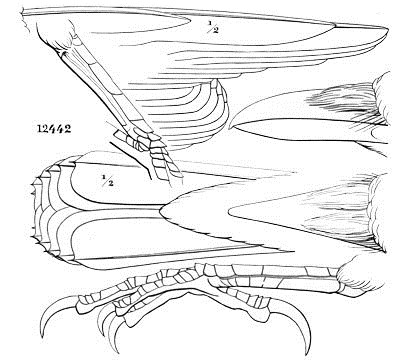
Corvus carnivorus.
12442
Gen. Char. The nasal feathers lengthened, reaching to or beyond the middle of the bill. Nostrils large, circular, overhung behind by membrane, the edges rounded elsewhere. Rictus without bristles. Bill nearly as long as the tarsus, very stout; much higher than broad at the base; culmen much arched. Wings reaching nearly or quite to the tip of the tail, the outer four primaries sinuated internally. Tarsi longer than the middle toe, with a series of small scales on the middle of each side separating the anterior scutellate portion from the posterior continuous plates. Sides of the head occasionally with nearly naked patches. Tail graduated or rounded.
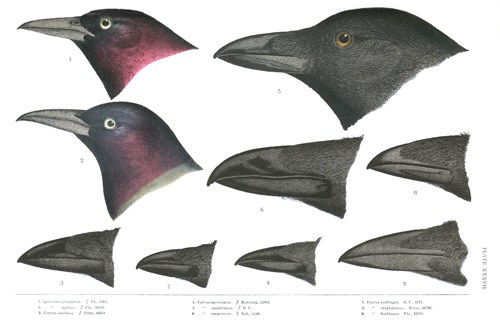
PLATE XXXVII
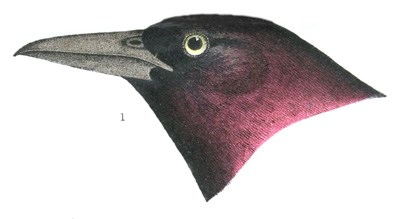
1. Quiscalus purpureus. ♂ Pa., 1363.
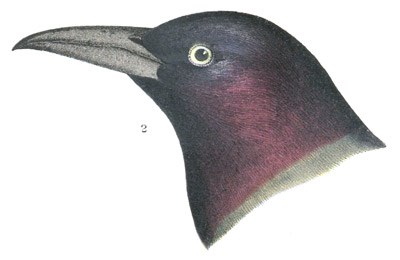
2. Quiscalus aglæus. ♂ Fla., 10342.
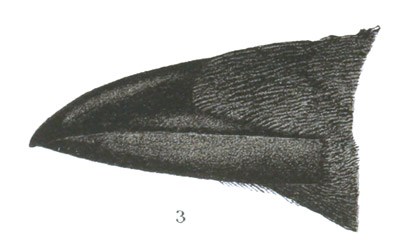
3. Corvus caurinus. ♂ Sitka, 46662.
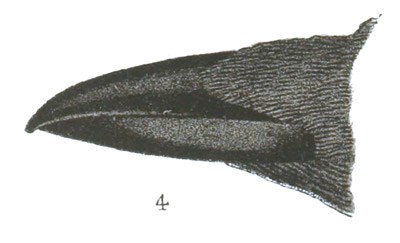
4. Corvus mexicanus. ♂ Mazatlan, 52802.
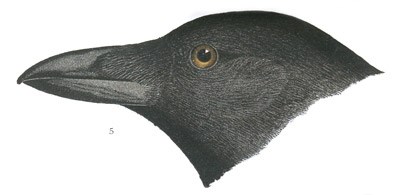
5. Corvus americanus. ♂ D. C.
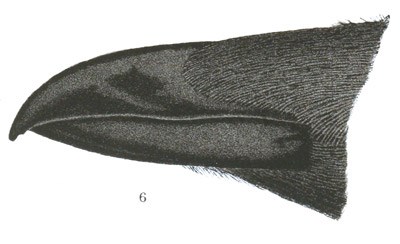
6. Corvus carnivorus. ♀ Neb., 4546.
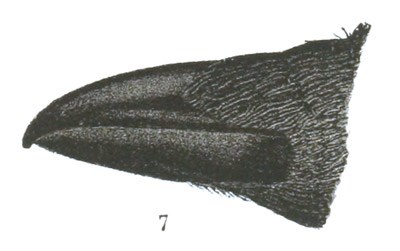
7. Corvus ossifragus. D. C., 4515.
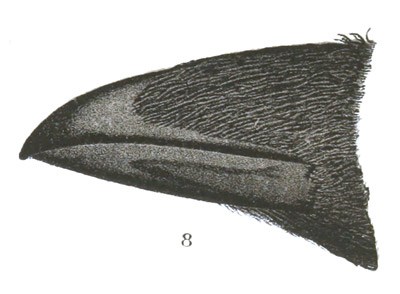
8. Corvus cryptoleucus. Texas, 46798.

9. Corvus floridanus. Fla., 10374.
Species and Varieties
RAVENS. Feathers of the chin and throat stiffened, elongated, narrow and lanceolate, with their outlines very distinct.
1. C. corax var. carnivorus. Length about 25.00; wing, 17.00; tail, 10.00; graduation of tail, 1.60 to 2.40. Feathers of the neck and breast light gray beneath surface. Hab. Whole of North America; Guatemala and Mexico. Rare in Eastern United States.
2. C. cryptoleucus. Length about 21.00; wing, 14.00; tail, 8.50; graduation of tail, about 1.25. Feathers of neck and breast snowy-white beneath surface. Hab. Llano Estacado, or Staked Plain of Texas; Arizona; Colorado.
CROWS. Feathers of chin and throat soft, short, broad, obtuse, and with their webs blended.
A. Angle of mouth feathered—North American Crows.
a. Tarsus longer than the bill. First quill not longer than tenth.
3. C. americanus. The gloss of the plumage purplish-violet, and hardly perceptible on head and neck, middle toe and claw rather shorter than tarsus, measured from beginning of scutellæ.
Wing, 12.25; tail, 7.20; culmen, 1.85; tarsus, 2.00; middle toe, 1.45; wing-formula, 4, 3, 5, 6, 2; first quill equal to tenth. Hab. North America generally … var. americanus.50
Wing, 12.50; tail, 7.20; culmen, 2.10; tarsus, 2.30; middle toe, 1.60. Wing-formula? (moulting). Hab. South Florida … var. floridanus.
4. C. ossifragus. The gloss of plumage violaceous-blue, almost green on the head, neck, and breast, where very perceptible. Middle toe and claw longer than tarsus, as above. Wing, 10.50; tail, 6.50; culmen, 1.55; tarsus, 1.65; middle toe, 1.35. Wing-formula, 4, 3, 5; first quill slightly shorter than tenth. Hab. Atlantic Coast of the United States.
b. Tarsus shorter than the bill. First quill longer than tenth.
5. C. caurinus. Gloss of the plumage as in americanus, but deeper. Wing, 10.50; tail, 6.40; culmen, 1.95; tarsus, 1.70; middle toe, 1.25. Wing-formula, 4, 3, 5. Hab. Northwestern coast of North America.
6. C. mexicanus.51 Plumage highly lustrous, blended. Soft burnished steel-blue, changing to violet on the crown, and with a greenish cast on lower parts. Wing, 9.00; tail, 6.50; culmen, 1.60; tarsus, 1.20; middle toe, 1.10. Wing-formula, 4, 3, 5. First quill very much longer than tenth. Hab. Western Mexico (Mazatlan, etc.).
B. Angle of mouth naked—West Indian Crows.
a. Tarsus much shorter than the bill.
7. C. nasicus.52 Nostrils scarcely concealed by the short nasal bristles. Entirely violaceous-black, the feathers smoky-gray beneath the surface. Wing, 11.00; tail, 7.75; culmen, 2.45; depth of bill, .80; tarsus, 1.95; middle toe, 1.50; graduation of tail about 1.00; wing-formula, 4, 3, 5, 6, 2; first quill shortest. Hab. Cuba.
8. C. leucognaphalus.53 Nostrils well concealed by the longer, but rather scant, nasal bristles. Entirely violaceous-black, the feathers of the neck all round, breast and sides, pure white below the surface. Wing, 12.50; tail, 9.00; culmen, 2.45; depth of bill, .95; tarsus, 2.15; middle toe, 1.50; graduation of tail about 1.25. Wing-formula, 4, 5, 3, 6, 2; first quill much the shortest. Hab. Porto Rico.
b. Tarsus about equal to bill.
9. C. jamaicensis.54 Nostrils just covered by the short but dense tuft of nasal bristles. Entirely dark sooty-plumbeous, inclining to black on the head, wings, and tail, where is a very faint violaceous gloss. Wing, 9.50; tail, 6.50; culmen, 2.00; depth of bill, 1.70; tarsus, 2.05; middle toe, 1.35; graduation of tail, about .60. Wing-formula, 5, 4, 3, 6, 2; first shortest. Hab. Jamaica.
Corvus corax, var. carnivorus, BartramAMERICAN RAVENCorvus carnivorus, Bartram, Travels in E. Florida, 1793, 290.—Baird, Birds N. Am. 1858, 560, pl. xxi.—Cooper & Suckley, 210, pl. xxi.—Coues, P. A. N. S. 1866, 225.—Lord, Pr. R. A. Inst. IV, 1864, 121 (British Columbia).—Dall & Bannister, Tr. Ch. Ac. I, 1869, 285 (Alaska).—Cooper, Orn. Cal. I, 1870, 282.—Samuels, 355. Corvus corax, Wilson, Am. Orn. IX, 1825, 136, pl. lxxv. f. 3.—Bonap. Obs. Wils. 1825, No. 36.—Ib. Syn. 1828, 56.—Doughty, Cab. N. H. I, 1830, 270, pl. xxiv.—Rich. F. B. Am. II, 1831, 290.—Nuttall, Man. I, 1832, 202.—Aud. Orn. Biog. II, 1834, 476, pl. ci.—Ib. Syn. 1839, 150.—Ib. Birds Am. IV. 1842, 78, pl. ccxxiv.—Heerm. X, S, 54.—Finsch, Abh. Nat. III, 1872, 40 (Alaska). Corvus cacalotl, “Wagler,” ? Bonap. Pr. Zoöl. Soc. 1837, 115 (perhaps true cacalotl).—Ib. List, 1838 (probably not of Wagler).—Ib. Conspectus, 1850, 387.—Maximilian, Reise innere Nord Amer. II, 1841, 289 (does not consider it different from European).—Newberry, P. R. R. Rep. VI, IV, 1857, 82. Corvus lugubris, Agassiz, Pr. Bost. Soc. N. H. II, Dec. 1846, 188.—Ib. Caban. J. VI, 1858, 195.—Baird, Birds N. Am. 1858, 563, pl. xx.—Kennerly, P. R. R. X., b pl. xxii. Corvus, var. littoralis, “Holböll, Kroger Tidsk. IV, 1843, 390.”—Schlegel, note on Corvus.
Sp. Char. Fourth quill longest; third and fifth about equal; second between fifth and sixth; first nearly equal to the eighth. Length, about 24.00 or 25.00; extent, 50.00 to 51.00; wing, about 17.00; tail, 10.00. Tail moderately graduated; the outer feather about 1.60 to 2.40 inches less than the middle. Entirely glossy black, with burnished violet reflections.
Hab. Entire continent of North America. Rare east of the Mississippi. South to Guatemala.

Corvus carnivorus.
Though easily distinguishable from the European bird, the American Raven is so nearly related to it as to be beyond doubt referrible to it as a variety. The differences presented in a very large series of both forms are, however, very constant and tangible. In the American bird the bill is always longer and less deep, and the plumage is more highly burnished, while the wings, especially the secondaries, are perceptibly of a more reddish violet than the other portions. Though in an immense series of American specimens many differences of form and size are noted, yet there is nothing sufficiently characteristic of any particular region to indicate more than one variety. As a rule, however, specimens from the high north exceed in size those from elsewhere, and have the bill more robust, though not so short as in the European bird; while those from the Middle Province and Mexico to Guatemala (= “cacalotl,” Baird et Auct.) have the plumage more brilliant than others, and frequently the bill very narrow.
Habits. Assuming that we must consider as but one species the two differing forms of Raven found in North America, we find this bird more or less common throughout nearly the whole continent. It is much more abundant in some regions than in others, and, as a general rule, is much more common and also more generally distributed in the western portion, where also its habits are remarkably different from the manners of its eastern representative.
It seems to be more or less common throughout the Arctic regions. Mr. Kennicott met with Ravens at Lake Winnipeg. Mr. MacFarlane found them abundant at Lockhart River, at Fort Anderson, and on the Lower Anderson River. Mr. Ross obtained them at Fort Simpson, Mr. Reid at Big Island, Mr. Clarke at Fort Rae, Mr. Lockhart at Fort Resolution, and Mr. Dall at Nulato, in Alaska.
Richardson speaks of it as abounding in the fur countries, where it frequents the barren grounds even in the intense winter cold, and where its movements are regulated by those of reindeer, musk-oxen, and other animals, which it follows, to assist in devouring whatever may be killed. Ravens are seen to collect from various quarters wherever any animal is slain, in order to feast on the offal, and considerable numbers are in constant attendance upon the several fishing-stations. He mentions a singular instance of the disposition of this bird to appropriate glittering objects of no value to it for food or anything else. A Raven was seen flying off with something in its claws, pursued by a number of its clamorous companions. Having been fired at, it dropped the object of contention, which proved to be the lock of a chest.



